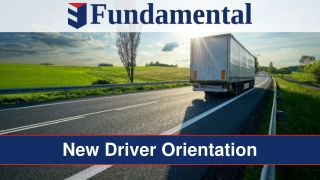Understanding New Jersey Mature Driver Challenges
New Jersey has a significant population of mature drivers aged 65 and older, accounting for 21% of licensed drivers. The proportion of crashes involving mature drivers has increased, with over 17% occurring in 2020. Vision, hearing, cognition, and physical condition changes with aging impact driving abilities, making adjustments necessary. Common issues include cataracts, hearing problems, cognitive issues, and physical conditions like arthritis. Medications can also affect driving, emphasizing the need for awareness and adaptation to ensure road safety.
Download Presentation

Please find below an Image/Link to download the presentation.
The content on the website is provided AS IS for your information and personal use only. It may not be sold, licensed, or shared on other websites without obtaining consent from the author. Download presentation by click this link. If you encounter any issues during the download, it is possible that the publisher has removed the file from their server.
E N D
Presentation Transcript
NEW JERSEY MATURE DRIVER RESOURCE CENTER TRAIN THE TRAINER
Introduction New Jersey s Mature Drivers 21% of NJ s licensed drivers are aged 65 or older Proportion of crashes increased to over 17% in 2020 Comprised almost 26% of all driver fatalities in 2020 Involved in 14% of both pedestrian and bicycle crashes (2016- 2020) Distracted driving a factor in over 25% of all crashes (2015-2019)
CHANGES WITH AGING Vision, Hearing, Cognition Physical Condition Making Adjustments
Changes with Aging Vision Hearing Cognition oMemory oMental alertness Physical Condition oReaction time oStrength and flexibility oRange of motion Medical Conditions Medications
Changes with Aging Vision Cataracts Macular Degeneration Glaucoma Changes in night vision, light sensitivity
Changes with Aging Hearing problems Sirens with car windows rolled up Clicking of turn signals when on High-pitched voices or sounds Following a conversation, especially when focused on driving
Changes with Aging Cognition Short-term memory issues Sleep disorders Stroke Vertigo Parkinson s disease Affect response time and wayfinding Increase distracted driving
Changes with Aging Physical Condition Arthritis Diminished muscle strength Tired muscles, sore joints Example Effects Difficult to turn neck to park Difficult to get into and out of car Limited ability to press brake and accelerator repeatedly
Changes with Aging Medication OTC medications may make you drowsy Certain prescription medications can also impair driving, including: o Antihistamines o Antianxiety/Antidepressant medication o Glaucoma medication o Parkinson s medication o Muscle relaxants o Opioids o Sleep aids Resources: https://www.nhtsa.gov/road-safety/older-drivers
Changes with Aging Making Adjustments Draw on driving experience No left turns Drive shorter distances Take more breaks Avoid rush hour and bad weather, and nighttime driving Use adaptive technology, but avoid distractions
Changes with Aging Dementia and Alzheimer's Hartford At the Crossroads Guidebook National Institute on Aging Alzheimer s Association
Changes with Aging General Resources Merck Manual https://www.merckmanuals.com/home/older- people%E2%80%99s-health-issues/the-older- driver/the-older-driver?redirect=vanity ChORUS Clearinghouse for Older Road User Safety https://www.roadsafeseniors.org/guides
Questions? www.maturedriversnj.org
DRIVING SAFER LONGER Assessment Instruction CarFit Vehicle Technology Vehicle Adaptation
Driving Safer Longer - Assessment Medical Review and Fitness to Drive Assessments NHTSA Driving Safely while Aging Gracefully: Self-Assessment HealthinAging.org Driving Safety Questionnaire AAA: Evaluate Your Driving Ability University of Florida: Fitness to Drive Screening Measure CHORUS Assessment Tools Certified Driving Rehabilitation Specialists (CDRS) Occupational Therapist with training in Driving Assessment
Driving Safer Longer - Instruction Online Courses AAA RoadWiseTM Driver courses AARP Smart Driver online course In-person Courses AAA RoadWiseTM Driver courses AARP Smart Driver in-person course NJ Motor Vehicle Commission list- Mature Defensive Driver Courses *There are costs associated with these trainings.
Driving Safer Longer - CarFit CarFit Program (AAA, AARP, and AOTA) Ensure vehicle fits driver properly AAA offers trainings Find trainings by state on the CarFit website American Occupational Therapy Association CarFit webpage CarFit events are free
Driving Safer Longer - Driving Technology Vehicle Technology Smart headlights (adaptive headlights) Emergency response systems Back-up cameras (reverse monitoring systems) Blind spot warning systems Lane departure warning systems Vehicle stability control Assistive parking systems Voice-activated systems Crash mitigation systems (collision avoidance) Drowsy driver alerts Resources AAA brochure AAA Vehicle Technology Videos
Driving Safer Longer - Rehabilitation Specialists Certified Driver Rehabilitation Specialist (CDRS) services Evaluate driver's physical and cognitive capabilities Recommend adaptive equipment Provide training to use adaptive equipment Provide rehabilitation services Costs vary NJ Motor Vehicle Commission CDRS List Association for Driver Rehabilitation Specialists (ADED) Search for NJ listing American Occupational Therapist Association (AOTA)
Driving Safer Longer - Adapting Your Vehicle Vehicle adaptations Larger panoramic rear and side mirrors Pedal extenders to reach brake and gas Hand controls for brake and gas Steering device to aid in grabbing wheel Seat belt adaptors Torso restraints to hold driver upright Turn signal adaptations Left foot accelerator Touch pad/voice activation systems for car controls/electronic joystick controls NHTSA Brochure The costs for these adaptations range widely.
Questions? www.maturedriversnj.org
DRIVING RETIREMENT How to Talk About Limiting or Stopping Driving Transition to Living Car-free Mobility Independence
Warning Signs of Unsafe Driving Warning signs and symptoms Uncomfortable, fearful or nervous while driving Difficulty staying in travel lane Getting lost in familiar places Trouble paying attention to road signs, pavement markings Slowing down when faced with unexpected situation Experiencing near misses Trouble gauging gaps in traffic at intersections, exit ramps, merges, or changing lanes Being easily distracted Recent tickets or warnings Dents or scrapes on the car, garage, fences, mailbox
Driving Retirement Think about: Meaning of driving from the older driver s perspective How to begin the driving discussion Strategies for driving reduction or retirement How to talk about navigating the community as a non-driver Local transportation options Starting the conversation before a crash or other crisis occurs Continuing the conversation over time
Driving Retirement The older driver may fear being: Unable to fulfill daily needs such as food, medication, exercise, social interactions Dependent on others Less spontaneous Isolated and lonely Less satisfied with life
Driving Retirement Family and friends may fear: the older driver's response appearing disrespectful not being able to help with transportation isolating the older driver the older adult not asking others for rides AARP We Need to Talk online seminar Florida s Guide to Safe Mobility for Life
Driving Retirement Conversation Starters I am concerned about your safety when you are driving. Driving isn t what it used to be. Have you asked your doctor about the effects of your new medication on driving? I m worried about you getting lost. I m glad you stopped driving at night. I don t want you driving if you are uncomfortable or feel it s too risky. Early, occasional, and candid conversations
Mobility Independence Reasons to stop driving Safety of the driver and other road users Costs of owning a car and the worry of repairs and maintenance Health benefits of walking or bicycling Lifestyle benefits such as meeting people, getting to know the neighborhood
Frequency per Year Total Cost per Year Mobility Independence Type of Cost Unit Cost Monthly Car Payment $500 x 12 $6,000 Reasons to stop driving Costs of owning a car and the worry of repairs and maintenance Annual Routine Maintenance Cost (i.e. oil changes) $110 x 1 $110 Annual Repair/Replacement Cost (i.e. tires, battery, transmission) $300 x 1 $300 Annual Auto Insurance $1,000 x 1 $1,000 Annual Licensing & Registration Fees $40 x 1 $40 Monthly Gas/Parking/Toll Costs $70 x 12 $840 Total Annual Cost $8,290 Adapted from: http://safemobilityfl.com/pdfs/CarCostWorksheet.pdf
Mobility Independence Needs of driving retirees: How do I get food? How do I get to medical appointments? How do I get to the park to walk? To the gym? How do I do other errands? How do I get to worship services? How do I visit friends?
Mobility Independence Mobility Options: ? Rides with Friends & Family Walkability Complete Streets Accessible Fixed Route Transportation Access Link Paratransit Community Transportation Mobility on Demand (UBER, Lyft)
Mobility Independence What are the options in this community? Local Senior Bus? Walking/bicycling? Ride with volunteer driver? Ride hailing/ Ride sharing? Paratransit? NJ TRANSIT?
Transition to Living Car-free Destinations Create a plan Where do I want to go? How often do I go? How far? What options are available? oFirst choice oAlternative Can I combine a trip or mode? Classes Community Center Community Events Doctor Dentist Family Friends Grocery/Supermarket Hair Salon/Barbershop Health Club Library Movies/Museums/Theaters Park Pharmacy Place of Worship Restaurants Other shopping Sporting Events Veterinarian Volunteering Work Florida s Guide to Safe Mobility for Life
Transition to Living Car-free Sample Transportation Plan Create a transportation plan Preferr ed Choice Alternative Option to Combine Trips? Where do I want to go? How often? How far? What options are available? List all destinations Ride with Family, Uber/Lyft, Bus Visit Family List all transportation options Senior Bus, Access Link, Grocery Delivery Grocery Store Exercise Class / Park Ensure option is comfortable Walk Walk, Ride with Friend Ensure option is practical Book Club Medical Appt. Ensure option is affordable Senior van (Van to return home) Organize by week or month Once/week Tuesday a.m. Ride w/ friend Senior van Lyft ride Ride w/ friend Community Center 1 mile N/A Place of Worship
Resources NHTSA How to Understand and Influence Older Drivers AARP/Hartford We Need to Talk AAA Senior Driver National Institute on Aging
Questions? www.maturedriversnj.org
TRANSPORTATION SERVICES NJ TRANSIT Paratransit Mobility on Demand Concierge Services Family and Friends Complete Streets Delivery
Transportation Services NJ TRANSIT Fixed route, schedule oBus oTrain oLight Rail Half-price fares for passengers 62+ years of age (65 for Metro-North Railroad) oDiscount available with proof of age Accessibility
Transportation Services Paratransit NJ TRANSIT Access Link curb to curb service eligibility process need reservations ADA complementary Contact: (800) 955-ADA1(2321) (800) 955-6765 (TT) adaservices@njtransit.com
NJTIP @ Rutgers Unsure how to use public transit? NJ Travel Independence Program at Rutgers teaches how to: Read bus and train schedules Plan trips Pay fares Take safety precautions Contact: Phone: 848-932-4499 Email: njtip_info@njtip.rutgers.edu
Community Transportation Services Community Transportation Services Use smaller lift-equipped vans and minibuses May operate curb to curb, door to door, or on an advance reservation basis May feed into existing mass transit bus stops, train or light rail stations May have eligibility requirements and may be restricted to senior citizens, people with disabilities, or social services clients Available in all NJ Counties County transportation links
Transportation Services Mobility on Demand Taxi Ride hailing/Ride sharing oLyft & Uber oApp needed Concierge Services oGo Go Grandparent oEZ Ryde4Life
Transportation Management Associations TMA Webpage Cross County Connection Greater Mercer TMA Seniors and Accessible Services Ride Provide Other Resources Ryde4Life EZ Ride goHunterdon Community Mobility Hudson TMA Transportation for Seniors Keep Middlesex Moving RideWise Active Adult Transportation Somerset County Transportation Guide Municipal Transportation Programs for Older Adults Avenues in Motion
Walkability and Bikeability A walkable community Improves quality of life people interact and develop a sense of community People living in a walkable community More likely to be socially engaged and trusting In better health and happier more often NHTSA Stepping Out as an Older Adult Pedestrian Safety Workshop: A Focus on Older Adults Complete Streets Health in Aging Foundation Walking Tips
Delivery Services Shopping Groceries Household Goods Clothing Books Pet food Meals Meals on Wheels Restaurants Pharmacy Medication
Reducing Isolation: Online access to cultural, social, recreational activities Participating in cultural, social and recreational activities online requires training in use of technology Examples Online book groups Museum talks and tours Readings Meetings Courses Theater programs Public Library Free Services
Resources Other Transportation Information: 2-1-1 New Jersey National Aging and Disability Transportation Center Rides in Sight DailyCaring
Resources NJ Mature Driver Resource Center www.maturedriversnj.org
Questions? www.maturedriversnj.org























